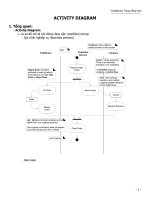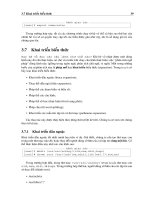MySQL Database Usage & Administration PHẦN 7 potx
Bạn đang xem bản rút gọn của tài liệu. Xem và tải ngay bản đầy đủ của tài liệu tại đây (577.86 KB, 37 trang )
202
Part I: Usage
Finally, XPath supports a number of different functions to work with nodes and
node collections. While it’s not possible to discuss them all here, it’s worthwhile
mentioning the count() function, which counts the number of nodes in a node
collection returned by a location path. Here’s an example, which counts the number
of ingredients in the recipe:
mysql> SELECT ExtractValue(@xml,
-> 'count(//ingredients/item)'
-> ) AS value;
+ +
| value |
+ +
| 6 |
+ +
1 row in set (0.01 sec)
No t e Other XPath functions, such as name() and id(), are not currently supported
by MySQL.
Updating Records and Fields
To update values in an XML document, MySQL offers the UpdateXML() function. This
function accepts three arguments: the source XML document, the location path to the
node to be updated, and the replacement XML. To illustrate, consider the next example,
which updates the author name:
mysql> SET @xml = UpdateXML(@xml,
-> '//author', '<author>John Doe</author>');
Query OK, 0 rows affected (0.00 sec)
mysql> SELECT ExtractValue(@xml, '//author');
+ +
| ExtractValue(@xml, '//author') |
+ +
| John Doe |
+ +
1 row in set (0.03 sec)
Here’s another example, which updates the second ingredient:
mysql> SET @xml = UpdateXML(@xml,
-> '//item[2]', '<item>Coriander</item>');
Query OK, 0 rows affected (0.01 sec)
mysql> SELECT ExtractValue(@xml, '//item[2]');
PART I
Chapter 8: Working with Data in Different Formats
203
PART IPART I
+ +
| ExtractValue(@xml, '//item[2]') |
+ +
| Coriander |
+ +
1 row in set (0.00 sec)
And here’s one that removes the final step from the recipe:
mysql> SET @xml = UpdateXML(@xml, '//step[@num=6]', '');
Query OK, 0 rows affected (0.00 sec)
mysql> SELECT ExtractValue(@xml, '//step[num=6]');
+ +
| ExtractValue(@xml, '//step[num=6]') |
+ +
| |
+ +
1 row in set (0.01 sec)
Importing XML
When it comes to importing XML data into a MySQL database, MySQL 5.1 is fairly
limited. It does not offer any easy way to convert structured XML data into table
records and fields, and only allows XML fragments to be imported “as is.” To illustrate,
consider the following simple XML document, which contains passenger records:
<?xml version='1.0'?>
<doc>
<pax>
<paxname>Rich Rabbit</paxname>
<flightid>652</flightid>
<flightdate>2009-01-20</flightdate>
<classid>3</classid>
</pax>
<pax>
<paxname>Zoe Zebra</paxname>
<flightid>652</flightid>
<flightdate>2009-01-27</flightdate>
<classid>2</classid>
</pax>
<pax>
<paxname>Zane Zebra</paxname>
<flightid>652</flightid>
<flightdate>2009-01-27</flightdate>
<classid>2</classid>
</pax>
204
Part I: Usage
<pax>
<paxname>Barbara Bear</paxname>
<flightid>652</flightid>
<flightdate>2009-01-20</flightdate>
<classid>2</classid>
</pax>
<pax>
<paxname>Harriet Horse</paxname>
<flightid>652</flightid>
<flightdate>2009-01-27</flightdate>
<classid>3</classid>
</pax>
</doc>
The LOAD_FILE() function, discussed in the previous section, can be used to import
the contents of a file into a table field, as follows:
mysql> CREATE TABLE p_tmp(
-> xmldata TEXT);
Query OK, 0 rows affected (0.46 sec)
mysql> INSERT INTO p_tmp (xmldata)
-> VALUES(LOAD_FILE('/tmp/in.xml'));
Query OK, 1 row affected (0.27 sec)
Look in the table, and you’ll see the imported XML document:
mysql> SELECT xmldata FROM p_tmp\G
*************************** 1. row ***************************
xmldata: <?xml version='1.0'?>
<doc>
<pax>
<paxname>Rich Rabbit</paxname>
<flightid>652</flightid>
<flightdate>2009-01-20</flightdate>
<classid>3</classid>
</pax>
<pax>
<paxname>Zoe Zebra</paxname>
<flightid>652</flightid>
<flightdate>2009-01-27</flightdate>
<classid>2</classid>
</pax>
<pax>
<paxname>Zane Zebra</paxname>
<flightid>652</flightid>
<flightdate>2009-01-27</flightdate>
<classid>2</classid>
</pax>
PART I
Chapter 8: Working with Data in Different Formats
205
PART IPART I
<pax>
<paxname>Barbara Bear</paxname>
<flightid>652</flightid>
<flightdate>2009-01-20</flightdate>
<classid>2</classid>
</pax>
<pax>
<paxname>Harriet Horse</paxname>
<flightid>652</flightid>
<flightdate>2009-01-27</flightdate>
<classid>3</classid>
</pax>
</doc>
1 row in set (0.00 sec)
The downside of this, of course, is that while the LOAD_FILE() function provides a
way to get XML data into MySQL, you can’t easily generate result sets from that data
using normal SELECT statements. MySQL 5.1 does include some support for XPath (as
discussed earlier in this chapter), and this can make your task easier … but this
approach is still far from perfect!
Other approaches to import structured XML documents into MySQL, such as that
shown in the previous example, involve using XSLT to reformat the XML data into
INSERT statements, which can then be executed through the MySQL client, or writing a
customized stored routine that parses the XML and inserts the values found into a
table. Here’s an example of the latter approach, which uses the ExtractValue()
function discussed earlier:
mysql> TRUNCATE TABLE p;
Query OK, 0 rows affected (0.01 sec)
mysql> DELIMITER //
mysql> CREATE PROCEDURE import_xml_pax(
-> IN xml TEXT
-> )
-> BEGIN
-> DECLARE i INT DEFAULT 1;
-> DECLARE c INT DEFAULT 0;
-> SET c = ExtractValue(xml, 'count(//pax)');
-> WHILE (i <= c) DO
-> INSERT INTO p (FlightID, FlightDate,
-> ClassID, PaxName, Note)
-> VALUES (
-> ExtractValue(xml, '//pax[$i]/flightid'),
-> ExtractValue(xml, '//pax[$i]/flightdate'),
-> ExtractValue(xml, '//pax[$i]/classid'),
-> ExtractValue(xml, '//pax[$i]/paxname'),
-> 'XML import via stored routine'
206
Part I: Usage
-> );
-> SET i = i + 1;
-> END WHILE;
-> END//
Query OK, 0 rows affected (0.01 sec)
You can now call this stored routine and pass it the source XML file:
mysql> CALL import_xml_pax(
-> LOAD_FILE('/tmp/in.xml')
-> );
A quick SELECT will verify that the records have been imported:
mysql> SELECT RecordID, FlightDate, ClassID, PaxName
-> FROM p;
+ + + + +
| RecordID | FlightDate | ClassID | PaxName |
+ + + + +
| 234 | 2009-01-27 | 2 | Zoe Zebra |
| 233 | 2009-01-20 | 3 | Rich Rabbit |
| 235 | 2009-01-27 | 2 | Zane Zebra |
| 236 | 2009-01-20 | 2 | Barbara Bear |
| 237 | 2009-01-27 | 3 | Harriet Horse |
+ + + + +
5 rows in set (0.00 sec)
Needless to say, this is a somewhat tedious approach, because you need to rewrite
the stored routine for different XML documents and tables (although you can certainly
make it more generic than the previous example).
If you’re using MySQL 6.0, things are much cheerier. This is because MySQL 6.0
includes a new statement, the LOAD XML statement, which can directly import
structured XML data as table records. This function, which is analogous to the LOAD
DATA INFILE statement discussed in the previous section, can read XML data that is
formatted using any of the following three conventions:
Element attributes correspond to field names, with attribute values representing •
field values:
<?xml version='1.0?>
<resultset>
<row PaxName='Zoe Zebra' FlightID='652' FlightDate='2009-01-27'
ClassID='2' />
</resultset>
Elements correspond to field names, with the enclosed content representing •
field values:
PART I
Chapter 8: Working with Data in Different Formats
207
PART IPART I
<?xml version='1.0'?>
<resultset>
<row>
<PaxName>Rich Rabbit</PaxName>
<FlightID>652</FlightID>
<FlightDate>2009-01-20</FlightDate>
<ClassID>3</ClassID>
</row>
</resultset>
Element 'name' attributes specify field names, with element content •
representing field values:
<?xml version='1.0'?>
<resultset>
<row>
<field name='PaxName'>Rich Rabbit</field>
<field name='FlightID'>652</field>
<field name='FlightDate'>2009-01-20</field>
<field name='ClassID'>3</field>
</row>
</resultset>
To illustrate, consider the following XML file, which is formatted according to the
second convention listed previously:
<?xml version='1.0'?>
<resultset>
<row>
<RecordID>201</RecordID>
<PaxName>Rich Rabbit</PaxName>
<FlightID>652</FlightID>
<FlightDate>2009-01-20</FlightDate>
<ClassID>3</ClassID>
<PaxRef>HH83282949</PaxRef>
</row>
<row>
<RecordID>202</RecordID>
<PaxName>Zoe Zebra</PaxName>
<FlightID>652</FlightID>
<FlightDate>2009-01-27</FlightDate>
<ClassID>2</ClassID>
<PaxRef>JY64940400</PaxRef>
</row>
208
Part I: Usage
<row>
<RecordID>203</RecordID>
<PaxName>Zane Zebra</PaxName>
<FlightID>652</FlightID>
<FlightDate>2009-01-27</FlightDate>
<ClassID>2</ClassID>
<PaxRef>JY64940401</PaxRef>
</row>
<row>
<RecordID>204</RecordID>
<PaxName>Barbara Bear</PaxName>
<FlightID>652</FlightID>
<FlightDate>2009-01-20</FlightDate>
<ClassID>2</ClassID>
<PaxRef>JD74391994</PaxRef>
</row>
<row>
<RecordID>205</RecordID>
<PaxName>Harriet Horse</PaxName>
<FlightID>652</FlightID>
<FlightDate>2009-01-27</FlightDate>
<ClassID>3</ClassID>
<PaxRef>JG74860994</PaxRef>
</row>
</resultset>
Here’s an example of how it could be loaded into a table:
mysql> TRUNCATE TABLE p;
Query OK, 0 rows affected (0.00 sec)
mysql> LOAD XML LOCAL INFILE '/tmp/in.xml'
-> INTO TABLE p;
Query OK, 5 rows affected (0.00 sec)
Records: 5 Deleted: 0 Skipped: 0 Warnings: 0
mysql> SELECT RecordID, PaxName, PaxRef FROM p;
+ + + +
| RecordID | PaxName | PaxRef |
+ + + +
| 201 | Rich Rabbit | HH83282949 |
| 202 | Zoe Zebra | JY64940400 |
| 203 | Zane Zebra | JY64940401 |
| 204 | Barbara Bear | JD74391994 |
| 205 | Harriet Horse | JG74860994 |
+ + + +
5 rows in set (0.03 sec)
Needless to say, the LOAD XML function can save you a great deal of custom
programming!
PART I
Chapter 8: Working with Data in Different Formats
209
PART IPART I
The LOAD XML statement supports an additional ROWS IDENTIFIED BY clause,
which specifies the XML element that marks the beginning and end of a single record
in the XML file, and comes in handy when working with XML data in different formats.
For example, if the input file looked like this:
<?xml version='1.0'?>
<resultset>
<paxdata>
<PaxName>Rich Rabbit</PaxName>
<FlightID>652</FlightID>
<FlightDate>2009-01-20</FlightDate>
<ClassID>3</ClassID>
<PaxRef>HH83282949</PaxRef>
</paxdata>
<paxdata>
<PaxName>Zoe Zebra</PaxName>
<FlightID>652</FlightID>
<FlightDate>2009-01-27</FlightDate>
<ClassID>2</ClassID>
<PaxRef>JY64940400</PaxRef>
</paxdata>
<paxdata>
<PaxName>Zane Zebra</PaxName>
<FlightID>652</FlightID>
<FlightDate>2009-01-27</FlightDate>
<ClassID>2</ClassID>
<PaxRef>JY64940401</PaxRef>
</paxdata>
<paxdata>
<PaxName>Barbara Bear</PaxName>
<FlightID>652</FlightID>
<FlightDate>2009-01-20</FlightDate>
<ClassID>2</ClassID>
<PaxRef>JD74391994</PaxRef>
<Note>Special meal</Note>
</paxdata>
<paxdata>
<PaxName>Harriet Horse</PaxName>
<FlightID>652</FlightID>
<FlightDate>2009-01-27</FlightDate>
<ClassID>3</ClassID>
<PaxRef>JG74860994</PaxRef>
<Note>Special service</Note>
</paxdata>
</resultset>
210
Part I: Usage
you could still import it using the following command:
mysql> LOAD XML LOCAL INFILE '/tmp/in.xml'
-> INTO TABLE p
-> ROWS IDENTIFIED BY '<paxdata>';
Query OK, 5 rows affected (0.01 sec)
Records: 5 Deleted: 0 Skipped: 0 Warnings: 0
Like the LOAD DATA INFILE statement, the LOAD XML statement also supports the
LOW_PRIORITY, CONCURRENT, REPLACE, and IGNORE keywords for greater control over
how XML data is imported.
Exporting XML
When it comes to exporting XML, MySQL currently lacks an equivalent to the SELECT
INTO OUTFILE statement, so XML-based export can only be accomplished using either
the mysql or mysqldump command-line tools.
To export the contents of a table using mysqldump, pass it the xml command-line
option, together with other connection-specific parameters. Here’s an example, which
generates an XML file containing airport records:
[user@host] mysqldump xml -u root -p db1 airport > /tmp/airport.xml
Password: ******
Here’s an example of the output:
<?xml version="1.0"?>
<mysqldump xmlns:xsi="
<database name="db1">
<table_data name="airport">
<row>
<field name="AirportID">34</field>
<field name="AirportCode">ORY</field>
<field name="AirportName">Orly Airport</field>
<field name="CityName">Paris</field>
<field name="CountryCode">FR</field>
<field name="NumRunways">3</field>
<field name="NumTerminals">2</field>
</row>
<row>
<field name="AirportID">48</field>
<field name="AirportCode">LGW</field>
<field name="AirportName">Gatwick Airport</field>
<field name="CityName">London</field>
<field name="CountryCode">GB</field>
<field name="NumRunways">3</field>
<field name="NumTerminals">1</field>
</row>
PART I
Chapter 8: Working with Data in Different Formats
211
PART IPART I
</table_data>
</database>
</mysqldump>
If you’re trying to generate custom output using a SELECT query and WHERE clause,
you’d be better off using the MySQL command-line client, which also supports the xml
argument. Here’s an example, which generates an XML file listing only those airports
with three or more runways:
[user@host] mysql xml -u root -p execute="SELECT AirportID,
AirportName FROM airport WHERE NumRunways >= 3" db1 > /tmp/airport.xml
Enter password: ******
And here’s a sample of the output:
<?xml version="1.0"?>
<resultset statement="SELECT AirportID, AirportName
FROM airport WHERE NumRunways >= 3"
xmlns:xsi="
<row>
<field name="AirportID">34</field>
<field name="AirportName">Orly Airport</field>
</row>
<row>
<field name="AirportID">48</field>
<field name="AirportName">Gatwick Airport</field>
</row>
<row>
<field name="AirportID">62</field>
<field name="AirportName">Schiphol Airport</field>
</row>
<row>
<field name="AirportID">72</field>
<field name="AirportName">Barcelona International Airport</field>
</row>
</resultset>
Summary
This chapter discussed the many ways of getting data into, and out of, MySQL. While
MySQL offers fairly sophisticated tools for importing and exporting data in standard
comma-separated or tab-delimited formats, its support for XML-encoded data is still
fairly primitive. MySQL 5.1 provides some XML-handling functions that are useful
when accessing and changing values in an XML document, while MySQL 6.0 offers a
new LOAD XML function that significantly simplifies the task of importing structured
XML data into a MySQL table.
212
Part I: Usage
In summary, however, while it is fairly easy to store an entire XML document “as
is” in a MySQL table, separating and storing XML data sets as individual records is still
a hard task—expect improvements to this aspect of the RDBMS in future releases.
To read more about the topics discussed in this chapter, consider visiting the
following links:
Importing records using the • LOAD DATA INFILE statement, at ql
.com/doc/refman/5.1/en/load-data.html
Exporting records using the • SELECT INTO OUTFILE statement, at http://
dev.mysql.com/doc/refman/5.1/en/select.html
Importing structured XML data using the • LOAD XML statement, at http://
dev.mysql.com/doc/refman/6.0/en/load-xml.html
XML functions in MySQL, at •
xml-functions.html
CHAPTER 9
Optimizing Performance
214
Part I: Usage
A
s your databases grow, you’ll find yourself constantly looking for ways to extract
better performance from them. While processor speed, bigger and faster disks,
and additional memory certainly have something to do with performance,
they’re outside the scope of this discussion. Instead, the intent of this chapter is to teach
you some techniques to improve server and query performance using the tools available
within MySQL to ensure that you’re getting the best possible performance from your
MySQL setup.
Newer MySQL features, such as stored routines and subqueries, can significantly
simplify complex database operations, but because of their relative new-ness, are not
yet completely optimized and so always incur some performance cost. This chapter
considers each of these features and offers some tips to help you improve their
performance.
Database design is another aspect to consider when discussing performance. Various
strategies for optimizing a table for better performance are, therefore, also a part of this
chapter. Most of the optimization you should do, however, first involves refining your
queries, adding indexes, and so forth. Accordingly, query optimization is considered
first in this chapter.
Optimizing Queries
One of the first places to look to improve performance is queries, particularly the ones
that run often. Big gains can be achieved by analyzing a query and rewriting it more
efficiently. You can use MySQL’s slow query log (described in Chapter 12) to get an
idea of which queries might be fine-tuned, and then try applying some of the techniques
in the following sections to improve their performance.
Indexing
A surprising number of people in online forums request information about slow
queries without having tried to add an index to a frequently accessed field. As you
know from Chapter 3, tables with fields that are accessed frequently can be ordered
by creating an index. An index points to the place on a database where specific data is
located, and creating an index on a field sorts the information in that field. When the
server needs to access that information to execute a query, it knows where to look
because the index points to the relevant location.
Indexing is even more important on multitable queries. If it takes a while to do a
full table scan on one table, imagine how much longer it would take if you have several
tables to check. If optimization of your queries is a goal, the first thing to do is to try
implementing an index.
Deciding which fields should be indexed involves several considerations. If you
have a field involved in searching, grouping, or sorting, indexing it will likely result in
a performance gain. These include fields that are part of join operations or fields that
appear with clauses such as WHERE, GROUP BY, or ORDER BY.
PART I
Chapter 9: Optimizing Performance
215
PART IPART I
Consider the following example:
SELECT a.AircraftID, at.AircraftName FROM
aircraft AS a JOIN aircrafttype AS at
ON a.AircraftTypeID = at.AircraftTypeID;
The fields that should be indexed here are aircraft.AircraftTypeID and aircrafttype
.AircraftTypeID because they’re part of a join. If this query is commonly repeated with
the same WHERE or HAVING clause, then the fields used in those clauses would also be
a good choice for indexing.
Another factor to consider here is that indexes on fields with many duplicate
values won’t produce good results. A table column that contains only “yes” or “no”
values won’t be improved by indexing. On the other hand, a field where the values
are unique (for example, employee Social Security numbers) can benefit greatly from
indexing.
You can associate multiple nonunique indexes with a table to improve performance.
No limit exists to the number of nonunique indexes that can be created.
Taking this to its logical extreme, then, you might think the more indexes, the
merrier. This is a fallacy: Adding an index doesn’t necessarily improve performance.
Small tables, for example, don’t need indexing. In addition, every index takes up
additional space on the disk—each indexed field requires MySQL to store information
for every record in that field and its location within the database. As your indexes
build, these tables begin to take up more room. Furthermore, indexing speeds up
searches, but slows down write operations, such as INSERT, DELETE, or UPDATE.
Until you work with indexing on your database, your first few attempts might not
achieve much performance gain.
Certain administrative counters can help you monitor your indexes or come up
with candidates for adding an index. Both the SHOW STATUS or mysqladmin extended-
status commands display values to consider in terms of indexes.
If your indexes are working, the value of • Handler_read_key should be high. This
value represents the number of times a record was read by an index value. A low
value indicates that not much performance improvement has been achieved by
the added indexing because the index isn’t being used frequently.
A high value for • Handler_read_rnd_next means your queries are running
inefficiently and indexing should be considered as a remedy. This value
indicates the number of requests to read the next row in sequence. This
occurs when a table is scanned sequentially from the first record to the last
to execute the query. For frequent queries, this is a wasteful use of resources.
An associated index points directly to the record(s), so this full table scan
doesn’t need to occur. Poorly functioning indexes could also result in a high
number here.
216
Part I: Usage
To view these counters, run a command like the one shown here:
mysql> SHOW STATUS LIKE 'handler_read%';
+ + +
| Variable_name | Value |
+ + +
| Handler_read_first | 0 |
| Handler_read_key | 23 |
| Handler_read_next | 0 |
| Handler_read_prev | 0 |
| Handler_read_rnd | 0 |
| Handler_read_rnd_next | 41 |
+ + +
6 rows in set (0.01 sec)
Ti p If your SELECT statements frequently end up sorting results by a particular field, use the
ALTER TABLE statement with an ORDER BY clause to re-sort the contents of the table by
that field. Your SELECT statements will then no longer need an ORDER BY clause, resulting
in faster and more efficient reads.
Once you’ve got your tables loaded with data and indexed the way you want them,
you should run the ANALYZE TABLE command on them. This command analyzes the
data in the table and creates table statistics on the average number of rows that share
the same value. This information is used by the MySQL optimizer when deciding
which index to use in table joins.
mysql> ANALYZE TABLE airport, aircraft, flight;
+ + + + +
| Table | Op | Msg_type | Msg_text |
+ + + + +
| db1.airport | analyze | status | OK |
| db1.aircraft | analyze | status | Table is already up to date |
| db1.flight | analyze | status | OK |
+ + + + +
3 rows in set (0.00 sec)
It’s a good idea to run the ANALYZE TABLE command frequently, especially after
you’ve added a significant amount of data to your table, to ensure that the optimizer is
always using the most efficient index.
Query Caching
When you run a SELECT query, MySQL “remembers” both the query and the results it
returns. This is accomplished by storing the result set in a special cache (called the
query cache) each time a SELECT query is executed. Then, the next time you ask the
server for the same query, MySQL will retrieve the results from the cache instead of
running the query again. As you can imagine, this speeds up the process considerably.
PART I
Chapter 9: Optimizing Performance
217
PART IPART I
Although enabled by default, you must always verify that query caching is turned
on, which can be done by checking the server variables. The following example illustrates:
mysql> SHOW VARIABLES LIKE '%query_cache%';
+ + +
| Variable_name | Value |
+ + +
| have_query_cache | YES |
| query_cache_limit | 1048576 |
| query_cache_min_res_unit | 4096 |
| query_cache_size | 0 |
| query_cache_type | ON |
| query_cache_wlock_invalidate | OFF |
+ + +
6 rows in set (0.00 sec)
The first variable, • have_query_cache, indicates the server was configured for
query caching when it was installed (the default).
The • query_cache_size variable indicates the amount of memory allotted for the
cache in bytes. If this value is 0, query caching will be off.
The values for the • query_cache_type variable range from 0 to 2. A value of 0 or
OFF indicates that query caching is turned off. ON or 1 means that query caching
is turned on, with the exception of SELECT statements using the SQL_NO_CACHE
option. DEMAND or 2 provides query caching on demand for SELECT statements
running with the SQL_CACHE option.
The • query_cache_limit variable specifies the maximum result set size that should
be cached. Result sets larger than this value will not be cached.
You can alter any of these variables using the SET GLOBAL or SET SESSION
statements, as shown:
mysql> SET GLOBAL query_cache_size = 16777216;
Query OK, 0 rows affected (0.00 sec)
To see for yourself what impact the query cache is having on performance, run the
same query with and without query caching to compare the performance difference.
Here’s the version without using the query cache:
mysql> SELECT SQL_NO_CACHE r.RouteID, a1.AirportCode, a2.AirportCode,
-> r.Distance, r.Duration, r.Status FROM route AS r,
-> airport AS a1, airport AS a2
-> WHERE r.From LIKE a1.AirportID
-> AND r.To LIKE a2.AirportID
-> AND r.RouteID IN
-> (SELECT f.RouteID
-> FROM flight AS f, flightdep AS fd
-> WHERE f.FlightID = fd.FlightID
218
Part I: Usage
-> AND f.RouteID = r.RouteID
-> AND fd.DepTime BETWEEN '00:00' AND '04:00');
+ + + + + + +
| RouteID | AirportCode | AirportCode | Distance | Duration | Status |
+ + + + + + +
| 1133 | MUC | BOM | 6336 | 470 | 1 |
| 1141 | BOM | SIN | 3913 | 320 | 1 |
+ + + + + + +
2 rows in set (0.21 sec)
Now perform the same query with the cache:
mysql> SELECT SQL_CACHE r.RouteID, a1.AirportCode,
-> a2.AirportCode, r.Distance, r.Duration, r.Status FROM
-> route AS r, airport AS a1, airport AS a2
-> WHERE r.From LIKE a1.AirportID
-> AND r.To LIKE a2.AirportID
-> AND r.RouteID IN
-> (SELECT f.RouteID
-> FROM flight AS f, flightdep AS fd
-> WHERE f.FlightID = fd.FlightID
-> AND f.RouteID = r.RouteID
-> AND fd.DepTime BETWEEN '00:00' AND '04:00');
+ + + + + + +
| RouteID | AirportCode | AirportCode | Distance | Duration | Status |
+ + + + + + +
| 1133 | MUC | BOM | 6336 | 470 | 1 |
| 1141 | BOM | SIN | 3913 | 320 | 1 |
+ + + + + + +
2 rows in set (0.02 sec)
Dramatic improvements in performance aren’t unusual if query caching is enabled
on frequent queries.
Ca u T i o n Once a table is changed, the cached queries that use this table become invalid and are
removed from the cache. This prevents a query from returning inaccurate data from the old
table. While this makes query caching much more useful, a constantly changing table won’t
benefit from caching. In this situation, you might want to consider eliminating query
caching. This can be done by adding the SQL_NO_CACHE option, as previously shown, to
a SELECT statement.
Query Analysis
Attaching the EXPLAIN keyword to the beginning of a SELECT query tells MySQL to
return a chart describing how this query will be processed. Included within this chart
is information on which tables the query will access and the number of rows the query
is expected to return. This information comes in handy to see which tables should be
indexed to speed up performance and to analyze where the bottlenecks are.
PART I
Chapter 9: Optimizing Performance
219
PART IPART I
Ca u T i o n Only queries that are textually exact will match what’s in the query cache; any
difference will be treated as a new query. For example, SELECT * FROM airport won’t
return the result from select * FROM airport in the cache.
As an example, consider the following query:
SELECT p.PaxName, f.FlightID
FROM pax AS p,
flight AS f, route AS r
WHERE p.FlightID = f.FlightID
AND p.ClassID = 2 AND r.Duration = 85;
Now, by adding the EXPLAIN keyword to the beginning of the query, one can obtain
some information on how MySQL processes it:
mysql> EXPLAIN SELECT p.PaxName, f.FlightID
-> FROM pax AS p,
-> flight AS f, route AS r
-> WHERE p.FlightID = f.FlightID
-> AND p.ClassID = 2 AND r.Duration = 85\G
*************************** 1. row ***************************
id: 1
select_type: SIMPLE
table: p
type: ALL
possible_keys: NULL
key: NULL
key_len: NULL
ref: NULL
rows: 30
Extra: Using where
*************************** 2. row ***************************
id: 1
select_type: SIMPLE
table: r
type: ALL
possible_keys: NULL
key: NULL
key_len: NULL
ref: NULL
rows: 290
Extra: Using where; Using join buffer
*************************** 3. row ***************************
id: 1
select_type: SIMPLE
table: f
type: eq_ref
220
Part I: Usage
possible_keys: PRIMARY
key: PRIMARY
key_len: 2
ref: db1.p.FlightID
rows: 1
Extra: Using where
3 rows in set (0.00 sec)
This might all seem a little intimidating, so an explanation is in order. The result of
EXPLAIN SELECT is a table listing all the SELECTs in the query, together with how
MySQL plans to process them.
The • id field indicates the position of the SELECT within the complete query,
while the table field holds the name of the table being queried.
The • select_type field indicates the type of query: a simple query without
subqueries, a UNION, a subquery, an outer query, a subquery within an outer
query, or a subquery in a FROM clause.
The • type field indicates how the join will be performed. A number of values are
possible here, ranging from const (the best kind of join, since it means the table
contains a single matching record only) to all (the worst kind, because it means
that MySQL has to scan every single record to find a match to records in the
other joined tables).
The • possible_keys field indicates the indexes available for MySQL to use in order
to speed up the search.
The • key field indicates the key it will actually use, with the key length displayed
in the key_len field.
The • rows field indicates the number of rows MySQL needs to examine in the
corresponding table to successfully execute the query. To obtain the total
number of rows MySQL must scan to process the complete query, multiply the
rows value for each table together.
The • Extra field contains additional information on how MySQL will process the
query—say, by using the WHERE clause, by using an index, with a temporary
table, and so on.
Now, from the previous output, it’s clear that in order to execute the query, MySQL will
need to examine all the rows in two of the named tables. The total number of rows MySQL
needs to scan, then, is approximately 290 × 30 = 8,700 rows—an extremely large number!
However, by reviewing the output of the EXPLAIN SELECT command output, it’s
clear that there is room for improvement. For example, the possible_keys field for some
of the tables is NULL, indicating that MySQL couldn’t find any indexes to use. This can
quickly be rectified by reviewing the tables and adding indexes wherever possible:
mysql> ALTER TABLE pax ADD INDEX (ClassID);
Query OK, 30 rows affected (0.06 sec)
Records: 30 Duplicates: 0 Warnings: 0
PART I
Chapter 9: Optimizing Performance
221
PART IPART I
mysql> ALTER TABLE route ADD INDEX (Duration);
Query OK, 290 rows affected (0.06 sec)
Records: 290 Duplicates: 0 Warnings: 0
Now, try running the query again with EXPLAIN:
mysql> EXPLAIN SELECT p.PaxName, f.FlightID
-> FROM pax AS p,
-> flight AS f, route AS r
-> WHERE p.FlightID = f.FlightID
-> AND p.ClassID = 2 AND r.Duration = 85\G;
*************************** 1. row ***************************
id: 1
select_type: SIMPLE
table: p
type: ref
possible_keys: ClassID
key: ClassID
key_len: 4
ref: const
rows: 1
Extra:
*************************** 2. row ***************************
id: 1
select_type: SIMPLE
table: r
type: ref
possible_keys: Duration
key: Duration
key_len: 2
ref: const
rows: 1
Extra: Using index
*************************** 3. row ***************************
id: 1
select_type: SIMPLE
table: f
type: eq_ref
possible_keys: PRIMARY
key: PRIMARY
key_len: 2
ref: db1.p.FlightID
rows: 1
Extra: Using where; Using index
3 rows in set (0.00 sec)
As you can see, MySQL is now using the newly added indexes to cut down on the
number of rows that need to be examined. Looking at the rows field for each table, we
now see that MySQL only needs to scan one row in each table to process the query—a
significant improvement over the earlier, nonindexed approach.
222
Part I: Usage
Optimizing Joins and Subqueries
A join is a multitable query performed across tables that are connected to each other
by means of one or more common fields. It is commonly used to exploit relationships
between the normalized tables of an RDBMS, and it gives SQL programmers the ability
to link records from separate tables to create different views of the same data.
A subquery is a SELECT statement nested inside another SELECT statement. A
subquery is often used to break down a complicated query into a series of logical steps
or to answer a query with the results of another query. As a result, instead of executing
two (or more) separate queries, you execute a single query containing one (or more)
subqueries.
Although MySQL comes with built-in intelligence to automatically optimize joins
and subqueries, this optimization is far from perfect. An experienced database
architect can often improve query performance by orders of magnitude through
simple tweaks to the way queries are written. With this in mind, the following section
outlines some common tips and tricks to help you maximize the performance of your
joins and subqueries.
Use Joins Instead of Subqueries
MySQL is better at optimizing joins than subqueries, so if you find the load averages
on your MySQL server hitting unacceptably high levels, examine your application code
and try rewriting your subqueries as joins or sequences of joins. For example, while the
following subquery is certainly legal:
SELECT r.RouteID, f.FlightID FROM route AS r, flight AS f
WHERE r.RouteID = f.RouteID AND r.Status = 1 AND f.AircraftID IN
(SELECT AircraftID FROM aircraft
WHERE AircraftTypeID = 616);
the following equivalent join would run faster due to MySQL’s optimization algorithms:
SELECT r.RouteID, f.FlightID FROM route AS r, flight AS f, aircraft AS a
WHERE r.RouteID = f.RouteID AND f.AircraftID = a.AircraftID
AND r.Status = 1 AND a.AircraftTypeID = 616;
It’s a good idea to match the fields being joined in terms of both type and length.
MySQL tends to be a little inefficient when using indexes on joined fields that are of
different lengths and/or types.
You can also turn inefficient queries into more efficient ones through creative use of
MySQL’s ORDER BY and LIMIT clauses. Consider the following subquery:
SELECT RouteID, Duration FROM route
WHERE Duration =
(SELECT MAX(duration) FROM route);
PART I
Chapter 9: Optimizing Performance
223
PART IPART I
This works better as the following query, which is simpler to read and also runs
much faster:
SELECT RouteID, Duration FROM route
ORDER BY duration DESC
LIMIT 0,1;
Use Session Variables and Temporary Tables
for Transient Data and Calculations
Session-based server variables can also come in handy if you want to avoid nesting
queries within each other. Therefore, while the following query will list all flights
where the current price is above average:
SELECT FlightID FROM stats
WHERE CurrPrice >
(SELECT AVG(CurrPrice) FROM stats);
you can accomplish the same thing by splitting the task into two queries and using
a server-side MySQL variable to connect them:
SELECT @avg:=AVG(CurrPrice) FROM stats;
SELECT FlightID FROM stats WHERE CurrPrice > @avg;
These two queries combined will run faster than the first subquery.
MySQL also lets you create temporary tables with the CREATE TEMPORARY TABLE
command. These tables are so-called because they remain in existence only for the
duration of a single MySQL session and are automatically deleted when the client that
instantiates them closes its connection with the MySQL server. These tables come in
handy for transient, session-based data or calculations, or for the temporary storage of
data. And because they’re session-dependent, two different sessions can use the same
table name without conflicting.
Since temporary tables are stored in memory, they are significantly faster than
disk-based tables. Consequently, they can be effectively used as intermediate storage
areas, to speed up query execution by helping to break up complex queries into simpler
components, or as a substitute for subquery and join support.
MySQL’s INSERT SELECT syntax, together with its IGNORE keyword and its
support for temporary tables, provides numerous opportunities for creative rewriting
of SELECT queries to have them execute faster. For example, say you have a complex
query that involves selecting a set of distinct values from a particular field and the
MySQL engine is unable to optimize your query because of its complexity. Creative
SQL programmers can improve performance by breaking down the single complex
query into numerous simple queries (which lend themselves better to optimization)
and then using the INSERT IGNORE SELECT command to save the results generated
to a temporary table, after first creating the temporary table with a UNIQUE key on the
appropriate field. The result: a set of distinct values for that field and possibly faster
query execution.
224
Part I: Usage
Here’s another example: Assume you have a table containing information on a
month’s worth of transactions, say about 300,000 records. At the end of each day, your
application needs to generate a report summarizing that day’s transactions. In such a
situation it’s not a good idea, performance-wise, to run SUM() and AVG() functions on
the entire set of 300,000 records on a daily basis. A more efficient solution here would
be to extract only the transactions for the day into a temporary table using INSERT
SELECT, run summary functions on the temporary table to generate the required
reports, and then delete the temporary table. Since the temporary table would contain
a much smaller subset of records, performance would be better and the server load
would also be lower.
CREATE TEMPORARY TABLE t_stats
SELECT CurrPrice FROM stats WHERE FlightDate = '2009-04-01';
SELECT @avg:=AVG(CurrPrice) FROM t_stats;
DROP TABLE t_stats
Explicitly Name Output Fields
It’s common to see queries like these:
SELECT (*) FROM airport;
SELECT COUNT(*) FROM airport;
These queries use the asterisk (*) wildcard for convenience. However, this convenience
comes at a price: The * wildcard forces MySQL to read every field or record in the table,
adding to the overall query processing time. To avoid this, explicitly name the output
fields you wish to see in the result set, as shown:
SELECT AirportID FROM airport;
SELECT COUNT(AirportID) FROM airport;
In a similar vein, when using subqueries with a WHERE or HAVING clause, it’s also a
good idea to be as specific as possible in the WHERE or HAVING clause to reduce the size
of the result set that needs to be processed by the outer query. If you’re using MySQL
from a client application over TCP/IP, following these simple rules will also reduce the
size of the result set that is transmitted to the client by the server, reducing bandwidth
consumption and improving performance.
Index Join Fields
Fields that are accessed frequently should be indexed. As a general rule, if you have
a field involved in searching, grouping, or sorting, indexing it will likely result in a
performance gain. Indexing should include fields that are part of join operations or
fields that appear with clauses such as WHERE, GROUP BY, or ORDER BY. In addition,
joining tables on integer fields, rather than on character fields, will produce better
performance.
PART I
Chapter 9: Optimizing Performance
225
PART IPART I
Rewrite Correlated Subqueries as Joins
When MySQL encounters a correlated subquery, it has to reevaluate the subquery once
for every record generated by the outer query. This is obviously expensive in terms of
performance, and so correlated subqueries should be avoided unless absolutely
necessary. Thus, you are far better off using joins, unions, multitable updates or
deletes, and temporary tables instead of correlated subqueries. As an example, consider
the following correlated subquery:
SELECT r.RouteID, r.From, r.To
FROM route AS r WHERE EXISTS
(SELECT 1 FROM flight AS f,
flightdep AS fd
WHERE f.FlightID = fd.FlightID
AND f.RouteID = r.RouteID
AND fd.DepTime BETWEEN '00:00' AND '04:00');
This would execute faster if rewritten as a join, as shown:
SELECT DISTINCT r.RouteID, r.From, r.To
FROM route AS r, flight AS f, flightdep AS fd
WHERE f.FlightID = fd.FlightID
AND r.RouteID = f.RouteID
AND fd.DepTime BETWEEN '00:00' AND '04:00';
Replace Materialized Subqueries with Temporary Tables
When subqueries are used in the FROM clause, MySQL materializes them by storing the
results in a temporary table. This temporary table is not automatically indexed, which
often results in MySQL having to perform a full table scan in order to satisfy the outer
query. Here’s an example:
SELECT x.DepDay FROM
(SELECT fd.DepDay, COUNT(fd.FlightID) AS c
FROM flightdep AS fd
GROUP BY fd.DepDay)
AS x
WHERE x.c >
(SELECT COUNT(fd.FlightID)/7 FROM flightdep AS fd);
An easy way to improve performance in these cases is to manually create (and index)
your own temporary table containing the result set of the inner query, and rewrite the
outer query to reference this temporary table. Here’s how you’d apply this principle to
the previous query:
CREATE TEMPORARY TABLE x (
INDEX (DepDay),
INDEX (c)) ENGINE=MEMORY
226
Part I: Usage
SELECT fd.DepDay, COUNT(fd.FlightID) AS c
FROM flightdep AS fd
GROUP BY fd.DepDay;
SELECT DepDay FROM x WHERE x.c >
(SELECT COUNT(fd.FlightID)/7 FROM flightdep AS fd);
Optimizing Transactional Performance
Because a database that supports transactions has to work a lot harder than a
nontransactional database at keeping different user sessions isolated from each other,
it’s natural for this to be reflected in the system’s performance. Compliance with the
other ACID rules, specifically the ones related to maintaining the integrity of the
database in the event of a system failure through the use of a transaction log, adds
additional overhead to such transactional systems. MySQL is no exception to this
rule—other things remaining the same, nontransactional MyISAM tables are much
faster than the transactional InnoDB and BDB table types.
That said, if you have no choice but to use a transactional table type, you can still do
a few things to ensure that your transactions don’t add undue overhead to the system.
Use Small Transactions
Clichéd though it might be, the KISS (Keep It Simple, Stupid!) principle is particularly
applicable in the complex world of transactions. This is because MySQL uses a row-level
locking mechanism to prevent simultaneous transactions from editing the same record
in the database and possibly corrupting it. The row-level locking mechanism prevents
more than one transaction from accessing a row at the same time—this safeguards the
data, but has the disadvantage of causing other transactions to wait until the transaction
initiating the locks has completed its work. So long as the transaction is small, this wait
time is not very noticeable. When dealing with a large database and many complex
transactions, however, the long wait time while the various transactions wait for each
other to release locks can significantly affect performance.
For this reason, it is generally considered a good idea to keep the size of your
transactions small and to have them make their changes quickly and exit so that other
transactions queued behind them do not get unduly delayed. At the application level,
two common strategies exist for accomplishing this.
Ensure that all user input required for the transaction is available before issuing •
a START TRANSACTION command. Often, novice application designers initiate
a transaction before the complete set of values needed by it is available. Other
transactions initiated at the same time now have to wait while the user inputs
the required data and the application processes it, and then asks for more data,
and so on. In a single-user environment, these delays will not matter as much
because no other transactions are trying to access the database. In a multiuser
scenario, however, a delay caused by a single transaction can have a ripple
effect on all other transactions queued in the system, resulting in severe
performance degradation.









